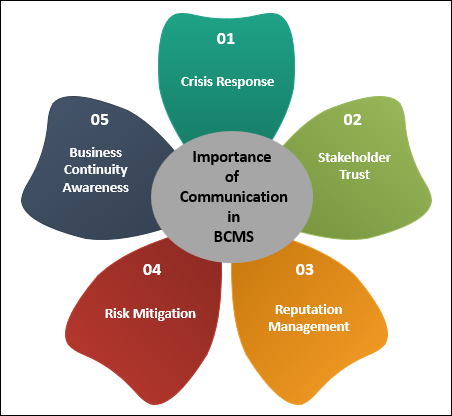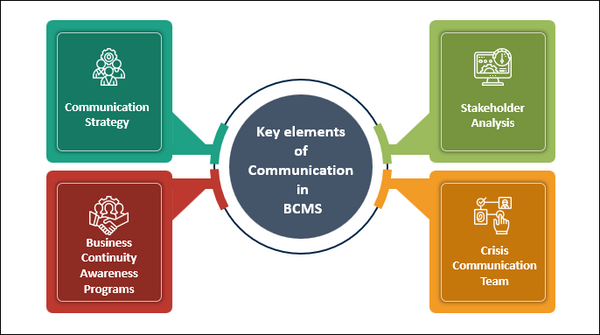Communication in BCMS
ISO 22301, the International Organization for Standardization's (ISO) standard for Business Continuity Management Systems (BCMS), plays a pivotal role in ensuring the resilience of organizations in the face of unexpected disruptions. One critical component of ISO 22301 is effective communication. In the ever-evolving business landscape, communication is the lifeblood of any successful BCMS. It is not merely about transmitting information, but also about fostering a culture of preparedness, collaboration, and adaptability.
This standard sets the framework for developing and implementing a robust communication strategy within BCMS, helping organizations weather crises with agility and maintain the trust of stakeholders. In this short paragraph, we'll delve into the significance of ISO 22301's communication requirements, highlighting its importance in safeguarding business operations and reputation during adverse times.
Importance of ISO 22301:Communication in BCMS
- Crisis Response: Effective communication is vital for coordinating and executing a swift response during a crisis. ISO 22301 emphasizes the need for clear lines of communication to ensure that everyone knows their roles and responsibilities when an incident occurs.
- Stakeholder Trust: Maintaining the trust and confidence of stakeholders, including customers, suppliers, and employees, is paramount. Proper communication ensures that stakeholders are kept informed about the situation and the organization's efforts to mitigate the impact of disruptions.
- Business Continuity Awareness: ISO 22301 promotes creating a culture of business continuity awareness within the organization. Communication is the vehicle through which employees are educated and motivated to contribute to continuity planning and execution.
- Risk Mitigation: Effective communication helps identify and address risks and vulnerabilities in a timely manner. Through regular risk assessments and reporting mechanisms, ISO 22301 assists in preventing potential disruptions.
- Resource Allocation: Proper communication facilitates the allocation of resources in an efficient manner during a crisis. This is crucial to ensure that critical functions are prioritized and sustained.
- Legal and Regulatory Compliance: Organizations often face legal and regulatory requirements for disclosure and communication during disasters. ISO 22301 provides a structured approach to meet these obligations.
- Reputation Management: Reputation is a valuable asset. ISO 22301 helps protect an organization's reputation by ensuring that it communicates transparently and responsibly during adverse events.
- Testing and Training: The standard encourages organizations to conduct regular testing and training exercises. Communication is key during these drills, as it helps in identifying gaps and refining response strategies.
- Global Best Practices: Following ISO 22301 ensures alignment with global best practices in BCMS. Clear communication is fundamental to these practices and helps organizations benchmark their efforts against international standards.
Key elements of ISO 22301:Communication in BCMS
- Communication Strategy: Develop a comprehensive communication strategy as part of your BCMS. This strategy should outline the objectives, target audiences, communication methods, and timing for various scenarios, including incident response and recovery phases.
- Clear Roles and Responsibilities: Define clear roles and responsibilities for communication within the organization. Designate individuals or teams responsible for disseminating information, both internally and externally, during a disruption.
- Stakeholder Analysis: Conduct a thorough stakeholder analysis to identify and prioritize key individuals or groups who need to be informed during a crisis. This should encompass customers, suppliers, employees, regulatory authorities, and other relevant parties.
- Information Flow: Establish a structured information flow within the organization. This includes protocols for collecting, verifying, and disseminating information.
- Communication Plans: Develop communication plans for various scenarios, considering the unique requirements of different types of disruptions. This should include templates, contact lists, and predefined messaging for different stakeholders.
- Crisis Communication Team: Form a dedicated crisis communication team with defined members and alternates. Train this team to respond effectively and maintain consistency in messaging under stressful conditions.
- Internal Communication: Prioritize internal communication to keep employees informed, engaged, and motivated during a crisis. Establish channels for rapid internal updates and instructions, promoting a culture of preparedness.
- External Communication: Craft external communication plans to address the needs of customers, suppliers, and the broader community. Ensure that messages convey the organization's commitment to continuity and its efforts to mitigate the impact.
- Media and Public Relations: If relevant, include media and public relations strategies in your BCMS. Define how the organization will engage with the media, manage public perceptions, and control the narrative during a crisis.
- Regulatory Compliance: Ensure that communication practices align with legal and regulatory requirements. Be aware of disclosure obligations and reporting deadlines specific to your industry and location.
- Training and Drills: Regularly train employees in communication procedures and conduct exercises to test the effectiveness of your communication plans. Use lessons learned to refine your strategies.
- Feedback and Improvement: Establish mechanisms for gathering feedback from stakeholders and team members after each incident or test. Use this feedback to continuously improve your communication processes.
- Documentation and Record-Keeping: Maintain detailed records of all communication activities. This includes messages sent, responses received, and any deviations from the communication plan. Documentation is crucial for audits and post-incident analysis.
- Monitoring and Alert Systems: Implement tools and systems for monitoring incidents and sending alerts when predefined thresholds or triggers are met. This ensures that communication can begin promptly.
- Business Continuity Awareness Programs: Develop programs to raise awareness about business continuity and communication within the organization. This helps ensure that everyone understands the importance of their role in maintaining continuity.
The Benefits for ISO 22301:Communication in BCMS
- Crisis Preparedness: Effective communication in BCMS helps organizations prepare for crises by establishing clear communication channels and protocols. This ensures that everyone knows their roles and responsibilities when an incident occurs, minimizing confusion and response time.
- Stakeholder Trust and Confidence: ISO 22301's focus on communication helps organizations maintain trust and confidence among stakeholders. Transparent and timely communication reassures customers, suppliers, employees, and regulatory bodies that the organization is managing disruptions competently.
- Enhanced Risk Management: Clear communication is fundamental to identifying and addressing risks and vulnerabilities. By promoting regular risk assessments and reporting mechanisms, ISO 22301 assists organizations in preventing potential disruptions and mitigating their impact.
- Resource Optimization: ISO 22301 encourages efficient resource allocation during crises. Effective communication ensures that critical functions are prioritized, minimizing downtime and financial losses.
- Legal and Regulatory Compliance: Organizations often have legal and regulatory requirements for disclosure and communication during disasters. ISO 22301 provides a structured approach to meet these obligations, reducing legal and compliance risks.
- Reputation Protection: Reputation is a valuable asset. ISO 22301 helps protect an organization's reputation by ensuring that it communicates transparently and responsibly during adverse events. This safeguards the brand's image and long-term success.
- Testing and Training Effectiveness: ISO 22301 promotes regular testing and training exercises. Effective communication during these drills helps organizations identify gaps in their plans, refine their response strategies, and build a more resilient BCMS.
- Continuous Improvement: ISO 22301 encourages a culture of continuous improvement. Effective communication allows organizations to gather feedback, learn from past incidents, and enhance their BCMS over time. This iterative process strengthens the organization's overall resilience.
- Global Best Practices: Following ISO 22301 aligns an organization with global best practices in BCMS. These practices often emphasize communication as a cornerstone of business continuity, enabling organizations to benchmark their efforts against international standards.
- Cost Savings: Effective communication minimizes operational disruptions and downtime, reducing financial losses associated with business interruptions. It helps organizations recover more efficiently and effectively.
- Competitive Advantage: Demonstrating a robust BCMS with effective communication practices can be a competitive advantage. Customers, partners, and stakeholders often prefer to engage with organizations that have reliable continuity plans in place.
- Community and Social Responsibility: In times of crisis, organizations with strong BCMS and effective communication contribute to the well-being of their communities. They play a socially responsible role by helping society maintain stability and recover faster.
- Brand Loyalty: Consistent and reliable communication during a crisis can foster brand loyalty. Customers and stakeholders who see an organization effectively managing disruptions are more likely to remain loyal and supportive.
- Employee Morale: Effective communication within a BCMS fosters a sense of security and trust among employees. This, in turn, boosts morale and motivation, as employees feel confident that their organization is well-prepared to handle challenges.
Conclusion
In conclusion, ISO 22301's focus on communication within Business Continuity Management Systems (BCMS) is indispensable for organizations seeking to navigate the complex landscape of modern business disruptions. Clear and efficient communication not only ensures swift crisis response but also safeguards stakeholder trust, compliance with legal obligations, and the preservation of reputation.
As organizations increasingly face diverse and unpredictable challenges, ISO 22301's communication principles provide a structured framework for building resilience and maintaining operational continuity. By prioritizing the cultivation of a proactive communication culture, businesses can embrace disruptions as opportunities to demonstrate their commitment to stakeholders, ultimately emerging stronger, more resilient, and better prepared for the uncertainties of the future.



